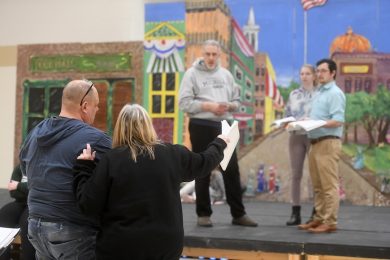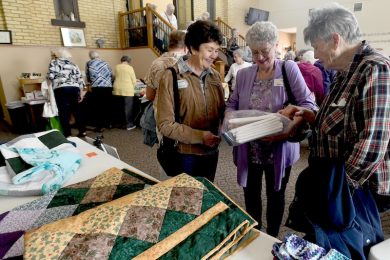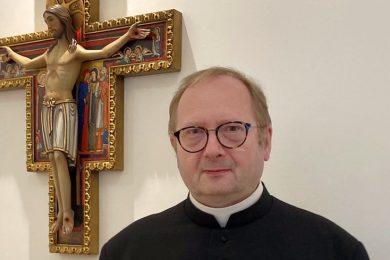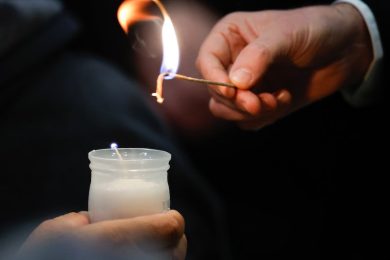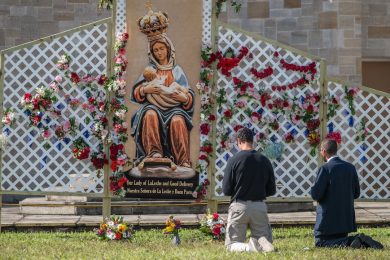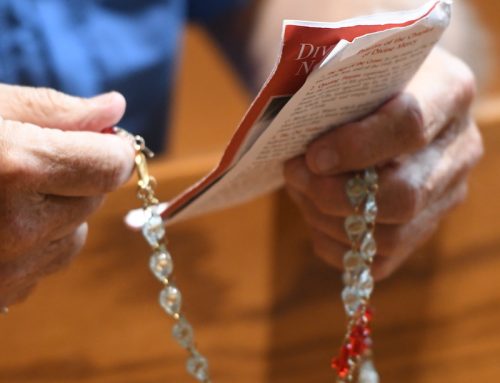By Gretchen R. Crowe | OSV News
It’s easy for Catholics to take the rosary for granted. We tend to purchase them as souvenirs, or carry them around with us, or even wear them — but we forget the immense power that they have when we actually pray them. And that’s really too bad, because a devotion to the rosary can be the answer to so many struggles in our 21st-century world.
Our society today faces growing secularism and the disappearance of faith from the public square. We find ourselves confronting a world awash in the spread of evil and terrorism, war and violence. We are plagued by broken families, abounding distractions and a general lack of drive for holiness.

But the rosary can help. And we know this because Mary herself told us this 100 years ago in Fátima, Portugal, when she appeared six times to three shepherd children from May to October 1917. She told them repeatedly: “Recite the rosary every day to obtain peace for the world and the end of the war.” Sister Lucia dos Santos, the eldest Fatima seer whom the church just declared “venerable,” emphasized the message of Mary, who introduced herself to the children as “Our Lady of the Rosary,” throughout her long life.
We also know the great value of the rosary because it has manifested its power time and time again in the lives of men and women of faith throughout history. This, of course, isn’t because the rosary is magical; it’s because it brings us to Jesus. As the late Cardinal Francis E. George, archbishop of Chicago, said at the conclusion of the Year of the Rosary in 2003: The rosary “brings us to the heart of the Gospel.”
In today’s typical lifestyle, it is easy to become distracted and overwhelmed by all of the “noise.” Technology is constantly demanding our attention. We sit in front of screens and, at the same time, look at smaller screens. We are drawn in by the lure of social media alerts and use texting as a primary form of communication. We have developed an “always on” or “always available” mentality, and noise no longer knows any boundaries. A recent Nielson report issued said that Americans, on average, spend 11 hours a day looking at some type of screen. It’s easy for us to tell ourselves we’re being productive and that this abundance of “screen time” is necessary, but the reality is that all that noise is damaging to our relationship with God.
This is not just a 21st-century problem, although it has become more pronounced in recent decades. In 1973, Cardinal Albino Luciani — then-archbishop of Venice who would go on to become Pope John Paul I — gave a homily that identified a “crisis of prayer” in the world — adding that part of the reason was due to the fact that “noise has invaded our existence.”
If he thought that life was noisy in 1973, what would Papa Luciani think of 2017?
We also face an abundance of internal noise. We are distracted by interior barriers to prayer that often manifest themselves in the form of pride and self-centeredness. In all of these moments of difficulty, we can turn to the rosary. The meditative quality of the devotion can help focus us and break through the external noise. At the same time, by praying this simple prayer frequently, faithfully and with humility, we can break down our internal barriers.
One of the intellectual, spiritual and even media giants of the 20th century was Archbishop Fulton J. Sheen. Archbishop Sheen also had a deep devotion to the Blessed Mother, and he dedicated a book to her called “The World’s First Love, Mary, Mother of God.”
He also spoke much about her in public. In a talk titled “The Woman I Love,” Archbishop Sheen indicated how Mary and the church were intertwined because “as we discontinue our devotion to the Blessed Mother, there is always a decline in the love of the church.” Fascinating, isn’t it? The less we pray to and venerate Mary, the less we are connected to the church. It would follow, then, that the opposite also is true. The more we honor and pray to Mary, especially in her signature prayer of the rosary, the more our love for and devotion to the church will increase.
And this is a devotion that we desperately need today. Catholics in the 21st century are experiencing a massive decline of love of the church. The country is experiencing a massive decline of love of the church. The country is experiencing a rise in the religiously unaffiliated, or “nones.” It also is facing a large — and growing — gap between the moral teachings of the church and the evolution of our secular society. Recent years have seen an increase in cultural mores and public policies at odds with church teaching, which means that church teaching is increasingly at odds with the laws of the land. Part of the problem is widespread lack of faith formation, particularly for many adult, cradle Catholics.
The universal call to holiness is expressed in the Second Vatican Council’s “Lumen Gentium” (Dogmatic Constitution on the Church) — which reminds us that we are called to “be perfect as your heavenly father is perfect.” When wanting to achieve holiness, where else is it better to look than to those men and women who have already done so — that is, the saints themselves. “The saints and blesseds of paradise remind us, as pilgrims on Earth, that prayer, above all, is our sustenance for each day so that we never lose sight of our eternal destiny,” St. John Paul said. “For many of them the rosary … was the privileged instrument for their daily discourse with the Lord. The rosary led them to an ever more profound intimacy with Christ and with the Blessed Virgin.”
Gretchen R. Crowe is the editor-in-chief of OSV News and the author of “Why the Rosary, Why Now?” (OSV, 2017).

